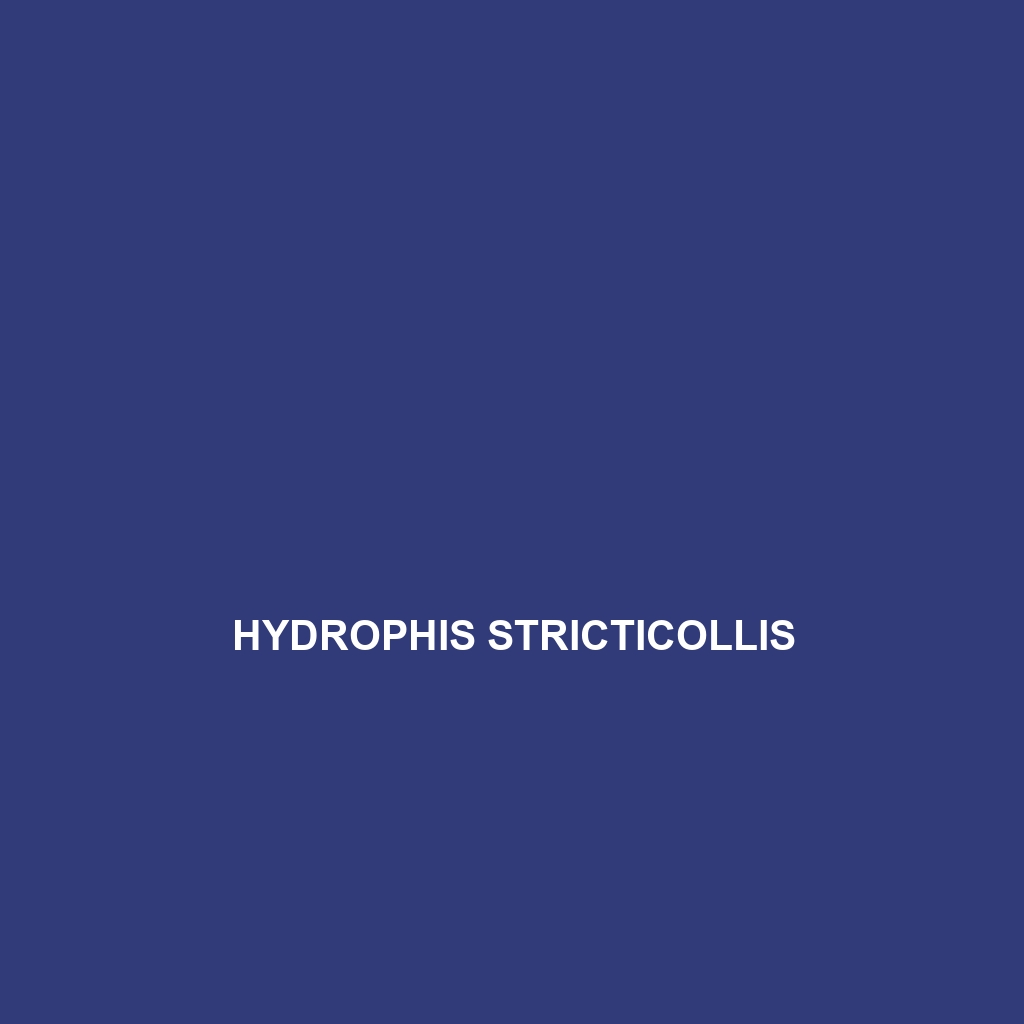Common Name
Hydrophis stricticollis
Scientific Name
Hydrophis stricticollis
Habitat
Hydrophis stricticollis, commonly known as the broad-headed sea snake, is primarily found in warm, coastal waters of the Indian and Pacific Oceans. This species prefers habitats such as shallow marine environments, estuaries, and coral reefs, often residing in areas with abundant underwater vegetation. The geographic distribution encompasses regions such as the coasts of the Philippines, Malaysia, and northern Australia. Typically thriving in tropical and subtropical climates, Hydrophis stricticollis is adapted to a habitat that demonstrates fluctuating temperatures and salinity levels, making it well-suited for life in diverse marine habitats.
Physical Characteristics
Hydrophis stricticollis exhibits notable physical characteristics that distinguish it from other sea snakes. Adults typically reach lengths of 1.5 to 2 meters (approximately 5 to 6.5 feet), with some individuals growing even longer. The body is slender and elongated, featuring a distinct broad head that can be visually separated from the neck, which contributes to its common name. The coloration is predominantly olive green or brown with lighter bands, providing effective camouflage among the seaweed and corals of their habitat. One of the unique features of this species is its paddle-shaped tail, which facilitates powerful swimming in marine environments, making it an effective predator.
Behavior
In terms of behavior, Hydrophis stricticollis is primarily aquatic, exhibiting a range of adaptations that support its life in the ocean. These snakes are known for their impressive swimming skills and can often be seen basking on the surface of the water or swimming gracefully underwater. They are generally non-aggressive towards humans but exhibit defensive behaviors when threatened. Forming loose social groups, these sea snakes can be observed interacting during mating rituals, which usually occur during the warmer months. Hydrophis stricticollis demonstrates nocturnal behavior, often hunting for prey under cover of darkness, which adds to its unique behavioral repertoire.
Diet
Hydrophis stricticollis is classified as a carnivore, primarily feeding on marine fish and eels. Their diet consists mainly of small fish species, which they capture using their highly developed venomous fangs. This species displays a fascinating feeding pattern, often ambushing unsuspecting prey or actively hunting in rocky crevices and among coral structures. Unlike some other reptiles, these snakes are known to vary their diet based on seasonal availability, showcasing flexibility in their feeding habits to optimize survival in their marine environments.
Reproduction
The reproductive cycle of Hydrophis stricticollis is fascinating, as they are ovoviviparous, meaning that females give birth to live young rather than laying eggs. Mating usually takes place in the late spring to early summer months, and the gestation period lasts around 4 to 6 months. A female can give birth to 5 to 15 offspring at a time, each measuring about 20 to 25 cm (approximately 8 to 10 inches) in length. Maternal care is limited; the young are instinctively capable of hunting soon after birth, which enhances their chances of survival in the wild.
Conservation Status
According to the IUCN Red List, Hydrophis stricticollis is currently classified as Least Concern, indicating a stable population in its natural habitat. However, challenges such as habitat destruction due to coastal development, pollution, and climate change pose potential threats to its long-term survival. Conservation efforts are focused on preserving marine ecosystems, enforcing fishing regulations, and minimizing pollution, which are essential to ensuring the continued prosperity of this species and its habitat.
Interesting Facts
One of the captivating aspects of Hydrophis stricticollis is its potent venom, which is a valuable adaptation for both hunting and self-defense. Unlike many land snakes, the venom of this sea snake is primarily neurotoxic, affecting the nervous system of its prey. Interestingly, despite its dangerous capabilities, there have been few reported bites to humans, suggesting that this species prefers to avoid confrontation. Additionally, Hydrophis stricticollis has an impressive ability to hold its breath underwater for extended periods, sometimes exceeding 30 minutes, which aids in hunting and evading predators.
Role in Ecosystem
Hydrophis stricticollis plays a vital role in marine ecosystems as both predator and prey. By controlling fish populations, these snakes contribute to maintaining a balanced marine biodiversity. As a predator, they help regulate the abundance of smaller fish species, preventing overpopulation within their habitat. Furthermore, Hydrophis stricticollis serves as a food source for larger marine predators, including sharks and larger fish species. Their presence indicates a healthy ecosystem, whereby fluctuations in their population may signal changes in marine health, making them a key species in the ecological framework.
